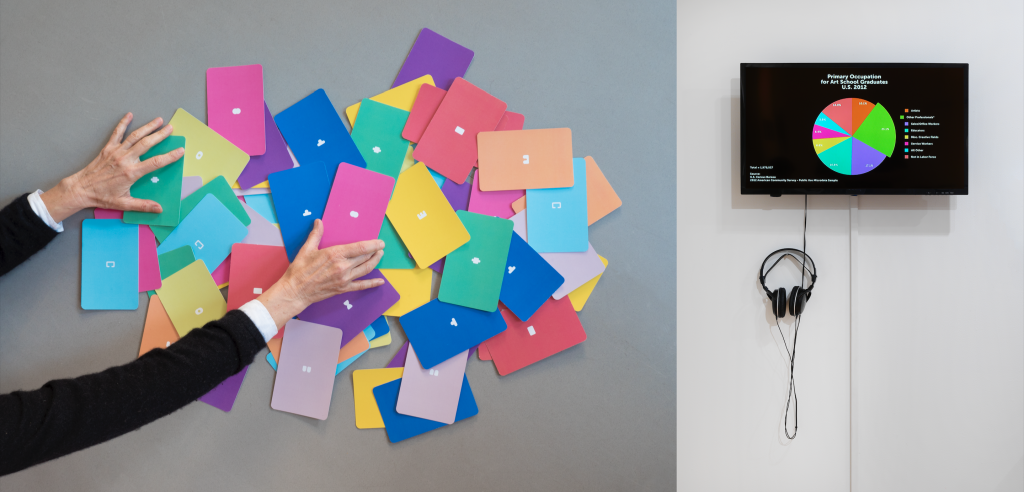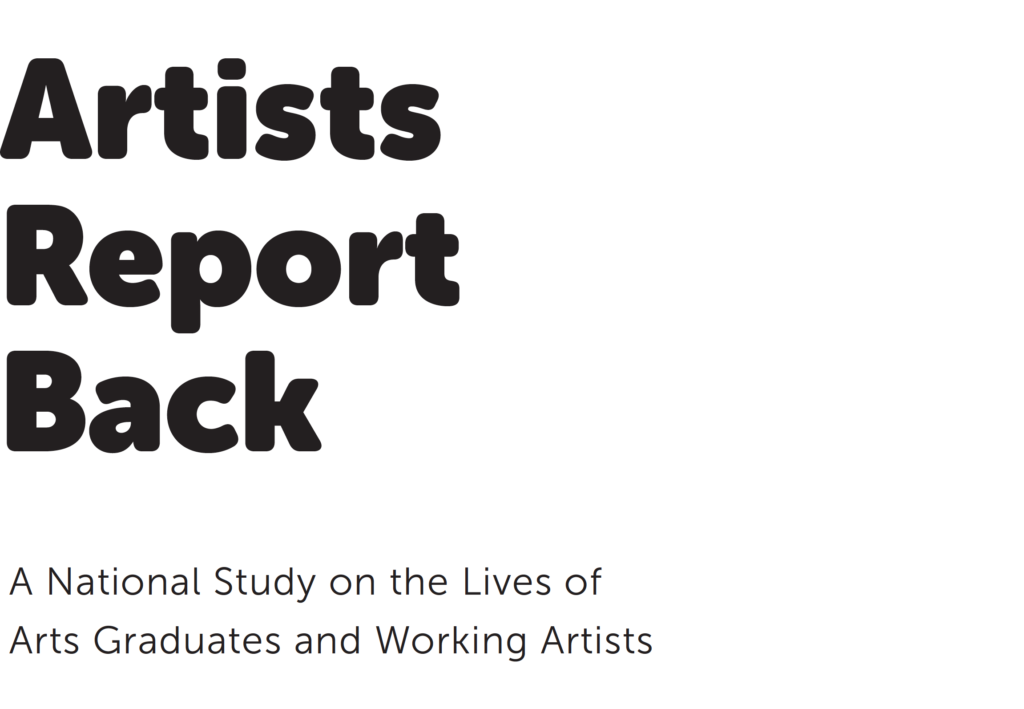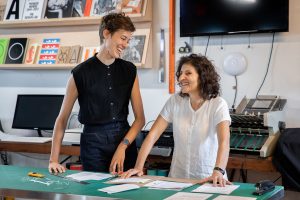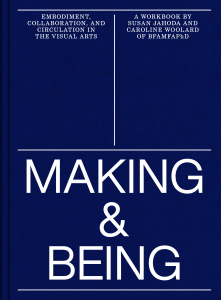


BFAMFAPhD is a collective that formed in 2012 to make art, reports, and teaching tools to advocate for cultural equity in the United States. The work of the collective is to bring people together to analyze and reimagine relationships of power in the arts. BFAMFAPhD core members are: Susan Jahoda, Emilio Martínez Poppe, Agnes Szanyi, Emily Tareila, Vicky Virgin, and Caroline Woolard.
Susan Jahoda is a Professor in Studio Arts at the University of Amherst, MA; Emilio Martínez Poppe is an MFA candidate at the University of Pennsylvania, Agnes Szanyi, is a Doctoral Student at The New School for Social Research in New York, NY, Emily Tareila is an artist and educator in Western Massachusetts, Vicky Virgin is a Research Associate with the Mayor’s Office for Economic Opportunity in New York, NY and Caroline Woolard is an Assistant Professor of Sculpture at The University of Hartford, CT. From 2016–2018, Emilio Martinez Poppe was a Fellow supporting Making and Being.
Structure
BFAMFAPhD has both a core group and contributors. To be a core member you must be aligned with BFAMFAPhD’s aesthetic and ethical principles. You must be aligned with the solidarity economy concept that “another world is not only possible—it already exists.” You must be interested in prioritizing the remaking of institutions over institutional critique for the sake of critique itself. You must be interested in looking for strategic opportunities to advance cultural equity in the arts and to build a community of rigor and care over a cynical, ironic, or antagonistic stance that denies our capacity to create change in the world.
People become group members by emailing us and asking to join the collective or by being invited in through existing relationships. The core group takes care of all of the administrative tasks that keep the collective alive. These include maintaining the website and caring for the well-being of members through events like collective meals, meditation, and movement practices. Friendship and emotional labor are central to our group agreements, and we privilege these in order to maintain the collective. One benefit of being in a collective is that we have five people to draw from. While one of us might be sick, two (or four) of us are likely rested and awake.
Contributors are people who have created projects that the core group has agreed to host. Contributors can also potentially become core members but are not responsible for the maintenance of the group and do not have the right to approve new contributions or to represent the group in public. Our book, Making and Being, is one contribution to the collective. Other core members of BFAMFAPhD are working on a wide range of projects, including a PhD dissertation about art and the sociology of professions by Agnes and a choreographic work about student debt by Vicky.
We invite contributions to BFAMFAPhD. Email us: info [at] BFAMFAPhD.com
To be a core member of BFAMFAPhD you must:
Projects: BFAMFAPhD is a collective that aims to provide a springboard for projects that are contributions to the collective. We share projects on the website and on social media, and help one another to realize exhibitions and performances. For example, Making and Being is a project that is a contribution to BFAMFAPhD. To have a project considered, anyone can submit a project to the core group. Each submission is discussed by the core members of the collective and, through consensus, it is determined whether the submission is aligned with our principles. Each contribution has its own economy of transfers. For example, Vicky bartered with people in the production of Fine Print, and Making and Being had a Fellow (Emilio from 2016-2018).
Fellowships: Emilio was a Fellow of the Project called Making and Being from 2016-2018. Emilio is also a member of BFAMFAPhD. Any project can have a Fellow, if collective members want that structure.

Download Artists Report Back, 2014
As artists and art school graduates, we often find ourselves in conversations about the difficulties of continuing our practice as writers, authors, artists, actors, photographers, musicians, singers, producers, directors, performers, choreographers, dancers and entertainers. We struggle to support ourselves with jobs outside of the arts and we struggle to earn a living in the arts. Yet art school administrators and “creative class” reports assure us that arts graduates make a living in the arts. Loan officers insist that art students can afford art school tuition, repaying student loans over time by working in the arts. This is not our experience. We decided that it was time make our own report.
Connecting our lived experiences to national trends, we wanted to know: What is the impact of rent, debt, and precarity on working artists and arts graduates nationally? How many of us are there? If we are not supporting ourselves as working artists, what jobs do we work?
We looked at artists’ demographics, occupations, educational attainment, field of degree, and earnings as recorded by the Census Bureau’s 2012 American Community Survey (ACS). The ACS is the largest survey that collects data about artists, surveying roughly 1 out of every 100 persons in the nation. With this data in hand, we made this report to reframe conversations about the current conditions and contradictions of arts graduates, and to make informed decisions about the ways we live and work. At the end of the report, please see our recommendations for organizational change and interpersonal action.
We see visual artists, creative writers, architects, and many people speaking up against rising debt, racial and gender inequity, and precarious labor in the arts. We are teaching that another way is possible – solidarity art worlds. We made Artists Report Back not as an argument of economic justification — it is a reflection on the conditions of cultural work in the United States today that paves the way for cultural equity initiatives locally and nationally.
 .
.
Making and Being offers a framework for teaching art that emphasizes contemplation, collaboration, and political economy. Authors Susan Jahoda and Caroline Woolard, two visual arts educators and members of the collective BFAMFAPhD, share ideas and teaching strategies that they have adapted to spaces of learning which range widely, from self-organized workshops for professional artists to Foundations BFA and MFA thesis classes. This hands-on guide includes activities, worksheets, and assignments and is a critical resource for artists and art educators today. Making and Being is a book, a series of videos, a deck of cards, and an interactive website with freely downloadable content.
PRE-ORDER the book here: https://pioneerworks.org/publishing/making-and-being-embodiment-collaboration-and-circulation-in-the-visual-arts/
DOWNLOAD teaching activities, assignments, and texts from Making and Being: click here for the 99-page PDF, an excerpt from the manuscript for our forthcoming book.
SAMPLE ACTIVITIES
Naming Who We Invite Into Our Space of Learning
Rubric for Self-Organized Learning
Social-Emotional Intelligence Project Reflection
Create an Object or a Time-Based Project That Will Benefit the Group

Author Bios
Susan Jahoda is Professor of Art at the University of Massachusetts, Amherst. Jahoda is an artist, educator, and organizer whose work includes video, photography, text, performance, installation and research-based collaborative projects. Works have been produced for venues in London, Paris, Basel, New York, Seoul, and Moscow. Jahoda is a core member of BFAMFAPhD and the Pedagogy Group, collectives of socially engaged artists and educators based in New York City.
Caroline Woolard is Assistant Professor of Sculpture at the Hartford Art School, CT and employs sculpture, immersive installation, and online networks to imagine and enact systems of mutual aid and collaboration. Her work has been featured twice on New York Close Up (2014, 2016), a digital film series produced by Art21 and broadcast on PBS. Woolard is the 2018–20 inaugural Walentas Fellow at Moore College of Art and Design and her work has been commissioned by and exhibited in major national and international museums, including at MoMA, the Whitney Museum, and Creative Time. Woolard is a core member of BFAMFAPhD.
BFAMFAPhD is a collective that formed in 2012 to make art, reports, and teaching tools to advocate for cultural equity in the United States. The work of the collective is to bring people together to analyze and reimagine relationships of power in the arts. BFAMFAPhD core members are: Susan Jahoda, Emilio Martínez Poppe, Agnes Szanyi, Emily Tareila, Vicky Virgin, and Caroline Woolard. More information is online at: http://bfamfaphd.com
SELECTED WEBSITE PUBLICATIONS
Caroline Woolard and Susan Jahoda of BFAMFAPhD, “Making and Being Card Game, created for Art Journal Open, Contemporary Projects, Pedagogies”, Art Journal Open, December 6, 2018.
SELECTED PRINT MEDIA
Léger, Marc James, “Neither Artist Nor Worker,” Esse, 94-Automne, 2018, p.21, 22.
Reyes, Jen Delos, “Re-thinking Art Education (Revisited) Or How I learned to Love Art School Again,” Beyond Critique: Contemporary Art in Theory, Practice, and Instruction, eds., Pamela Fraser, Roger Rothman, New York: Bloomsbury Publishing, 2017, Part 3, Chapter 14, p. 171.
Walker, Celeste, M, “BFAMFAPhD,” An Adjunct Professor’s Personal Experience with Student Debt Long After Leaving Graduate School,” The Neoliberal Agenda and the Student Debt Crisis in U.S. Higher Education, eds., Nicholas D. Hartlep, Lucille L.T. Eckrich, Brandon O. Hensley, New York: Routledge, 2017, Part 2 Chapter 6.
Frenette, Alexandre and Steven J. Tepper, “What Difference Does it Make? Assessing the Effects of Arts-based Training on Career Pathways,” Higher Education and the Creative Economy, eds., Roberta Comunian, Abigail Gilmore, New York: Routledge, 2016. Chapter 5. 84-85.
Satinsky, Abigail, “Movement Building for Beginners,” Art Journal, 74.3 (Fall 2015). 50-66.
Berlatsky, Noah, “What Can You Really Do With a Degree in the Arts?,” The Atlantic, November 6, 2014.
Guida, John, “If David Byrne Does Not Care About Contemporary Art, Should We?,” New York Times, October 29 2014.
Ferdman, Roberto A., “If you’re lucky enough to earn a living from your art, you’re probably white,” The Washington Post, October 21, 2014.
Schjeldahl, Peter, “Local Heroes: The Brooklyn Museum surveys recent art from the borough,” The New Yorker, October 20, 2014.
SELECTED PODCASTS
BFAMFAPhD, Bad at Sports: 8 Podcasts on Making and Being at Hauser & Wirth, forthcoming in 2019.
BFAMFAPhD, Bad at Sports: Live from Our Elevator Space at Open Engagement, Episode 629, 46 minutes, May 22, 2018.
SELECTED ONLINE PERIODICALS
Thyrza Nichols Goodeve, “The Art of Institutional Possibility: CAROLINE WOOLARD with Thyrza Nichols Goodeve,” The Brooklyn Rail, LMAKgallery, February 7, 2018.
Gretchen Coombs, “The Visible Hand at Cue Foundation,” Temporary Art Review, April 20, 2017.
Alexis Clements, “How Art Making is a Type of Management,” Hyperallergic, February 6, 2017.
Dimitris Lempesis, “ART CITIES:N.York-The Visible Hand ART VIEW,” Dreamideamachine, January 2017.
Sullivan, Andrew, “It’s A Hard Smock Life,” The Dish, October 25 2014.
Satinsky, Abigail, “Who Pays Artists?,” Bad at Sports, October 24, 2014.
Brooks, Katherine, “Most Artists Who Make A Living From Their Work Are White, Research Says,” The Huffington Post, Arts and Culture, October 24, 2014.